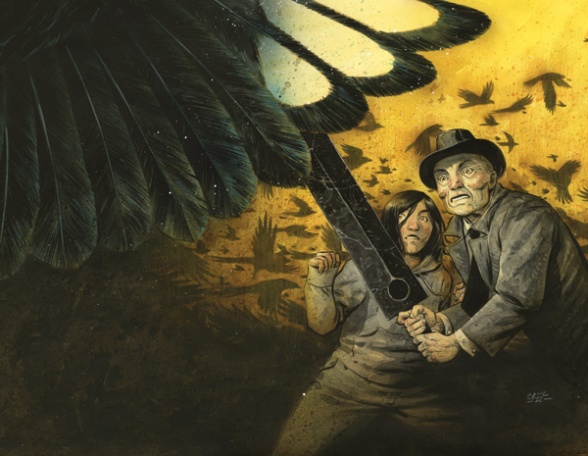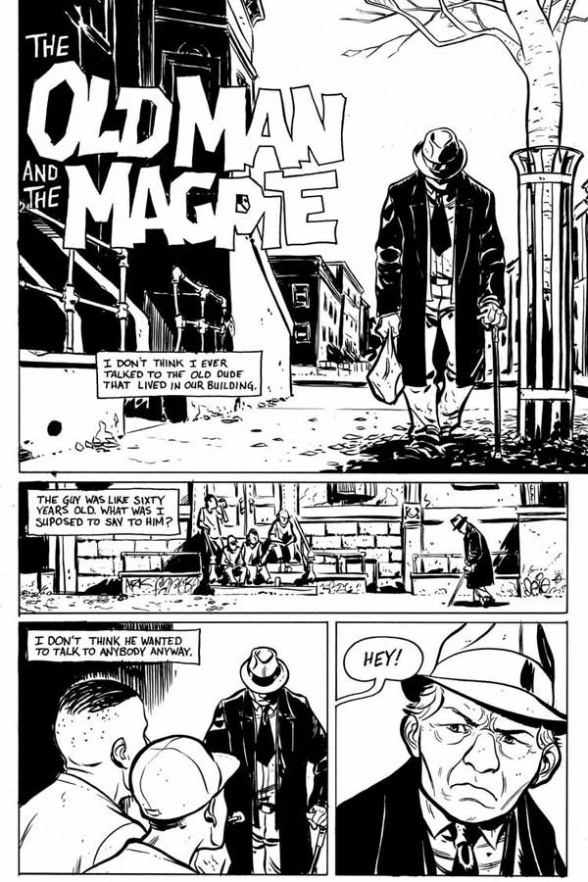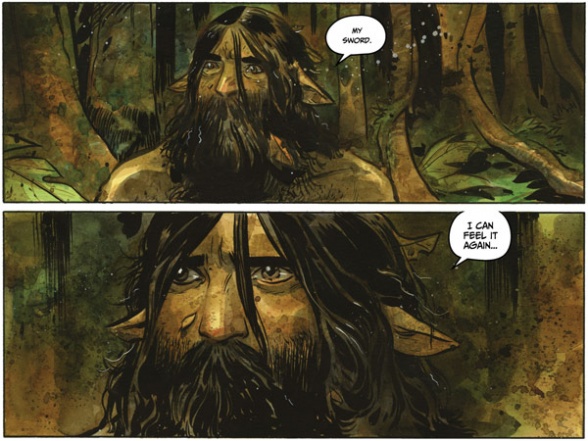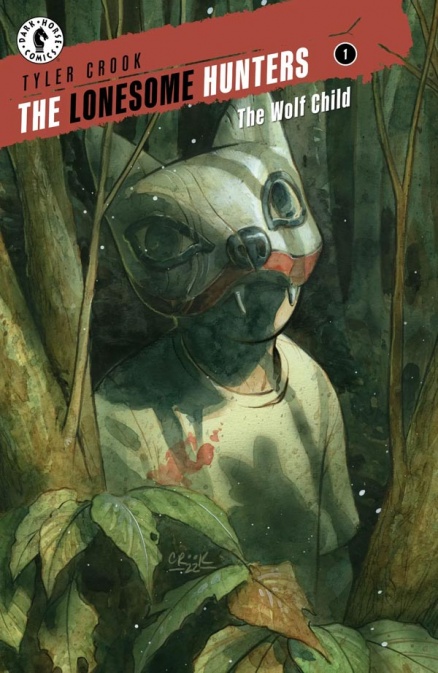The last time Multiversity Comics discussed “The Lonesome Hunters” with Tyler Crook, the series hadn’t come out yet, so we couldn’t dive into the series in any real detail. Now, with the first arc complete, we can do more of a deep dive, so there will be full spoilers for “The Lonesome Hunters” #1–4 ahead. If you aren’t up to date yet, you can pick up the trade paperback collection this Wednesday, February 22 and swing by here afterward.

“The Lonesome Hunters” is a story you’ve had kicking around in your brain for at least ten years now. I believe you even started drawing a version of this story back in 2012.
Tyler Crook: The origins of the idea was to have a series that was just about Howard and Lupe going out and having kind of “monster of the week” kinds of adventures. I imagined a serialized story that essentially reset to the status quo. I have a real love for that kind of serialized storytelling. The kind of stuff that Gun Smoke or The A-Team did to great effect. So the idea was that each story arc would be called “The Old Man and the. . .” Y’know, whatever the monster was in that story arc. But I quickly started to realize that I was putting too much focus on the character of Howard and not giving enough thought and agency to Lupe. And the longer I thought about her and how the two of them could build a relationship, the more the story evolved into a character driven story where the monsters mostly existed to drive Howard and Lupe into a place of self discovery.

Honestly, it was such a long process with so many twists and turns that it’s hard to even remember sometimes how these ideas evolved. Especially because the final result is so different from where it started. And I went down a lot of different paths that ended up being dead ends.
Even in this early version of the story Lupe exists as the narrator. Throughout the first arc we learnt about her through Howard. Though they are very different in a lot of ways, she presents him as someone she can understand and relate to. Is this a dynamic that developed very early on since she’s very much the voice of the series?
Tyler: Yeah, that’s true. Lupe has always been the narrator of the story. At first, it was just something that I did intuitively. Like, it just seemed like the thing to do. But now I think it is going to end up serving a greater narrative purpose. But that purpose is something we won’t find out until the end.
As far as how they relate to one another, I think my only idea at the beginning was that they were both very lonely. And they recognised that loneliness in each other.
So now that you’ve completed an entire arc of “The Lonesome Hunters” and you’re at work on a second, what’s your process like both writing and drawing?
Tyler: My process is still evolving. It usually involves trying to do two or three things at once. Like, I usually start outlining on paper, but I’ll switch to dictating stuff to my iPad when it feels faster, and I’m making scribbles in my sketchbook at the same time with ideas of what stuff might look like. Then I transfer my outline to a “book map,” which is a sheet of paper with every page laid out in a grid. That way I can see how many pages I expect each scene to take up and I can plan my page turns and stuff. I usually go through a few drafts of outlines like that before I feel like I’m ready to write.
The real writing begins when I start doing layouts and writing dialogue. That part usually happens at the same time. I’ll have a blank page where I make very rough layouts. They are comically bad, often taking less than a minute to draw. But at the same time, I’m writing a full script, by dictating it to my computer or iPad. I’m not the fastest typist in the world, so I do a lot of dictating. And when I can hear my dialogue out loud it helps me to make it sound more natural.
Continued belowFor me, it’s hard to juggle the writing with the visual presentation. I’m always trying to do both at the same time. I think I’m a very straightforward story teller. My page layouts aren’t very flashy or experimental but I try to make every panel have a clear and strong purpose. To be honest, the most important part of my writing process is slowly walking around my neighborhood trying to solve story problems.
My favorite scene in this first arc is after Howard and Lupe leave Tina’s and they’re driving along, talking about an anime called Mecha-Sabre Gemini. It doesn’t so much move the plot forward, but it really digs into the dynamic of both of them feeling isolated from their families, feeling even more cut off after death, but at the same time there’s this wonderful spark of connection between them—it feels like a distillation of their relationship. How did this scene come about?

Tyler: It sort of came from two places. One: When I first got into comics, I was a bit older than a lot of my colleagues who were also just starting out. And when we hung out, they were always telling me about media that I had totally missed. A lot of anime and webcomics and stuff like that. It made me feel like an old man, haha.
And two: I had just finished watching Neon Genesis Evangelion which actually has a lot of themes that are similar to the themes in “The Lonesome Hunters.” So I kind of merged those two ideas by making up my own anime story for Lupe to be obsessed with. I wanted it to be one that would have the kinds of themes that Howard could identify with. And the kind of story that Howard would wish he had access to as a kid.
Honestly, that’s one of my favorite scenes in the whole book. There is nothing quite like going for a long drive in a small car with someone you barely know. And it was important to take some time to grow their relationship. They both have very specific information that the other person needs. And if I don’t show these kinds of moments to the reader, I worry that their relationship will feel fake.
I’m curious, if Mecha-Sabre Gemini ever makes an appearance in the comic, do you think you’d attempt to do the anime style or would you perhaps work with a manga artist for those moments?
Tyler: We’ll have to see! I have been doing weekly live streams on my YouTube channel and recently did one where I sketched some possible designs for Mecha-Sabre Gemini mechs. I don’t know for sure how or if they will appear in “The Lonesome Hunters,” but it was fun to think about and noodle around with.
I love that you make space for moments like the Mecha-Sabre Gemini conversation, and it’s something I see again and again throughout “The Lonesome Hunters.” You make space for character-focused moments. And in single issues, where page real estate is very limited, nothing says “this is important” like giving a moment space.

Tyler: I really want readers to root for these characters. But I want to earn it. So I need to make the space and take the time to make them feel real. And at the same time I want to give the reader different points where they can rest and reflect on what’s happening in the story. So I have to turn down the volume from time to time.
And I think you do that in a way that’s very specific. I look back at the four issues, and each has an opening double-page spread. Each has this element of feeling the weight of time to it, but I want to focus on issue #3’s spread in particular.

It’s Lupe’s “original trauma” scene. It uses the same color palette as Howard’s “original trauma” in the issue #1 prologue. And in light of everything we’ve experienced with the character in issues #1 and #2, it really made me feel the weight of this on Lupe. I sat with this page for a bit before continuing on. And it stuck with me because there are so many ways this information could’ve been conveyed. This could’ve been a bunch of panels across two pages instead, showing Lupe’s mom’s funeral, the crying, making pancakes with her dad, his funeral, before getting to this moment with Lupe alone with her suitcase.
Continued belowBut by making that one moment the whole double-page spread, we really feel the weight of her being alone. By not seeing her mother or father, we really feel their absence. The compositional choices you’ve made here make this moment hit so much harder.
Tyler: I have a thing about splash pages. For me, they serve a very specific purpose within a serialized comic book. I try to design them to slow down the reader. I want my splash pages to transition the reader out of their real life and into the story world. To be honest, it bums me out that splash pages have gone out of fashion over the years. So in that respect, that scene had to start with a splash rather than a series of panels.
Working out how to choose moments like this can be really hard. Twenty-two pages is not a lot of room. Kurt Vonnegut has his eight basics of creative writing and number five is “Start as close to the end as possible.” I have found that advice to be very helpful. Readers are smart and they are very creative. If you show them the clear results of an action, they can usually figure out what the action leading up to it was. So this scene is all about showing the result of Lupe losing her parents. That was one of the ideas behind that scene.
The other, more important idea behind this scene is that I’m more interested in how people live with trauma and less interested in the specifics of that trauma. I think we all have gone through traumatic changes. And when we do, we often have so much work to do. Whether it’s a funeral, or a natural disaster or whatever, there’s always a bunch of stuff to do and people to talk to. But after a while, things calm down and you get to stop and rest. I wanted to capture the weight of that moment for Lupe. The moment that is equal parts loneliness, despair and exhaustion. The only thing left for Lupe to do is to live the rest of her life. And for her at that moment, it feels like an impossible task.
This plays into the ending too, and I don’t mean the fight with the Magpie Queen, but the aftermath of that, when Lupe makes Howard realize he can’t be careless with his life, that he means something to her. Up to that point, Howard has been deciding the next course of action on his own, but after this they figure out their next step together. And I like that you use staging to convey this point. When Lupe is expressing her frustrations, the two stand on opposite sides of the road, then Howard makes the decision to change and crosses over to her side.

Tyler: That’s just me trying to make sure that the point is being made. It’s what comics are so good at. When a character is feeling small, you draw them small on the page. If they feel separated then you show them being separated, you stick a car between them. I also made that scene aggressively dark. Maybe too dark, haha. Because that’s how they both feel; that things are black. And they are both so alone in the world that they can just stop in the middle of the road and no one will interrupt them. Sometimes I worry that I’m being a little bit heavy handed with this kind of stuff but the longer I do this, the more I think it’s impossible to go too far with comics.
You’d be surprised how many people miss that stuff. I’ve seen some readings of comics that the reader could’ve only got to by ignoring virtually every compositional choice on the page and taking all the dialogue and captions at face value. Subtlety is overrated—sometimes you’ve got to go for clarity instead.
I appreciate how much you let the visuals tell the story. Like the way you approached the design of the Magpie Queen. It’s a design that tells us about the character and gives us a sense of how old she is without a word being said.
Continued below
Given the fantasy element at play in “The Lonesome Hunters,” I’m excited to see how you approach others in future arcs. Could you tell us how this character came about and how she evolved as the story developed?
Tyler: One of the things that “The Lonesome Hunters” is concerned with is time and aging. I really like the idea of very long life changing characters. Sort of how Golum in The Lord of the Rings was all screwed up from being super old (and also living in a cave, I guess). In my mind the Magpie Queen was once one of those people with a bird on her head, but over the centuries, she grew in treasure and power until she was super big and cool looking.

In the first sketch I have of her, she is much more human looking. I may have had in mind that she was a human that controlled magpies at the time, but I don’t fully remember. I went through a few other designs, some scarier and weirder than others. Eventually, I landed on the design I used in the book where she’s wearing that wooden mask. I liked the mask because it felt like the type of thing that a human had made that she had stolen, and taken as her treasure. I think she turned into a very fun character.
And it’s great because we’ve seen how a magpie perched on a human host’s head is vulnerable, so it’s not hard to imagine that part of the original impulse to wear that mask was to protect the magpie. That and it’s a great signifier of importance—like a crown in that regard.
Tyler: I hadn’t actually thought of that! But it makes a lot of sense.
The last time we spoke, we talked a bit about the design of the sword, and how it was partially inspired by the relationship between Guts and his sword in “Berserk.” In that story, Guts trained as a child with an adult-sized sword, so as an adult his enormous sword serves to show that he’s dealing with his problems the same way he did as a child. We couldn’t talk more about that at the time because “The Lonesome Hunters” #1 hadn’t yet come out, but this element of in some ways being stuck as a child is a big part of Howard. (Hell, you even gave him pockmarks, literally scars from adolescence on his face.) The big sword makes him look small and when we see him in action, it’s not presented as cool—he’s terrified and awkward. The sword isn’t just an insight into Howard though, since we quickly discover it belongs to some kind of god. Given it’s chisel-like design, I can’t help but wonder if the god even thinks of it as a sword first or whether he thinks of it as more of a tool.

Tyler: There is still a lot to be discovered about the sword and about its owner. The sword and how it is used is going to continue to be very important to the story. So, there’s not a lot I can say about it right now.
But in general, I try hard to design stuff to tell the story, either by reinforcing the larger story arc or by telling the story of an object or environment and how it fits into the world. You mentioned Howard’s pockmarks and I can’t even express how clever I felt when I added them to his character design. Because, as you say, they are physical scars from his childhood that mirror the emotional scars that we can’t see directly. And there are smaller things, like a dent in a door frame, or the detritus on the dashboard of their car that are details intended to tell the story of that thing or that environment. My drawing style isn’t exceptionally detailed but the details that I include tend to be very intentional. These are the kinds of details that aren’t individually critical to the story but they add up as the story moves along to create a more fully realized world. At least, I hope they do.
Continued belowBefore we go, “The Lonesome Hunters: The Wolf Child” has just been announced over at AIPT for May. Knowing how much you enjoy drawing canines (I adore your “Beasts of Burden” variant cover), I’m looking forward to seeing how you approach them in this new arc.
Tyler: Yeah! I love drawing animals! I don;t know how much I want to say about the wolves in the next story arc except that they are weird and hopefully interesting in an unexpected way.

“The Lonesome Hunters” returns May 31 for a second arc, the four-issue miniseries ‘The Wolf Child.’ Don’t miss it.

Written and illustrated by Tyler Crook
On sale May 31, 2023
Full color, 32 pages
$3.99
MiniseriesAfter defeating the Magpie Queen with a powerful ancient sword, monster hunters Howard and Lupe are on their way to get rid of it when car trouble leaves them stranded in a small town that is being terrorized by a magical wolf and a mysterious child in a wolf mask. While waiting for car repairs, Lupe befriends the child and she and Howard are drawn into a war between the townspeople and the deadly beasts.



